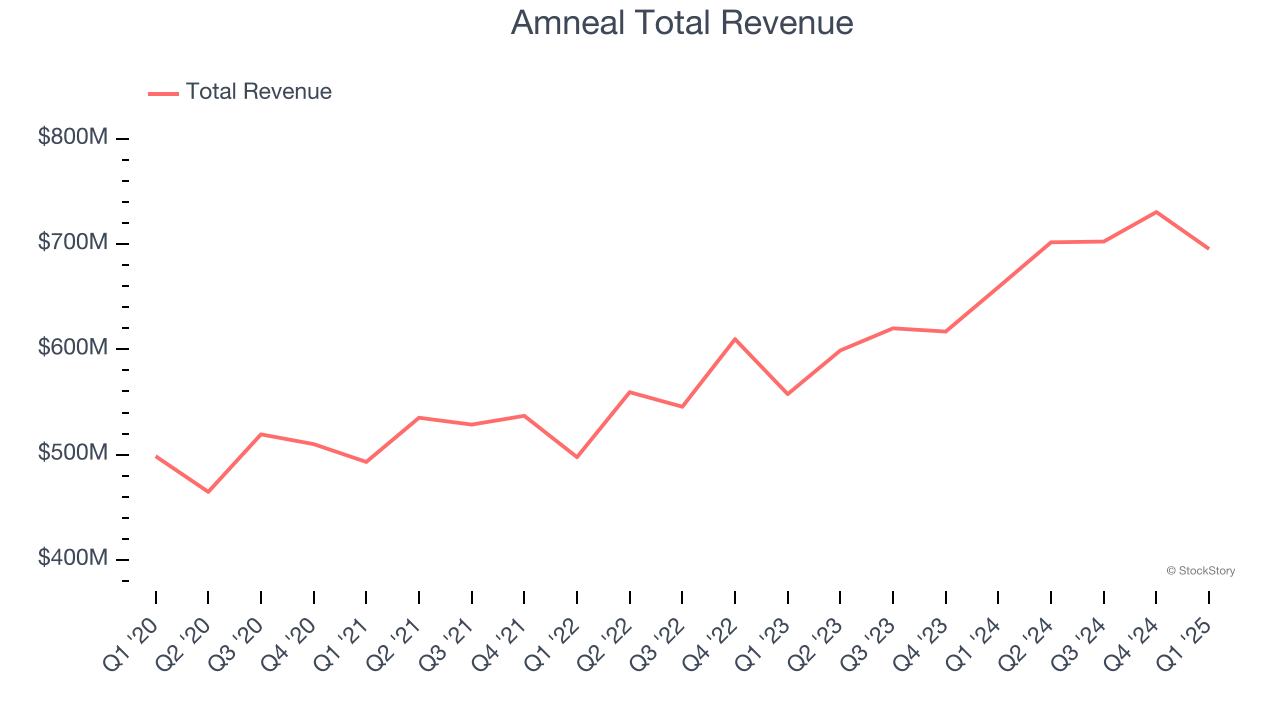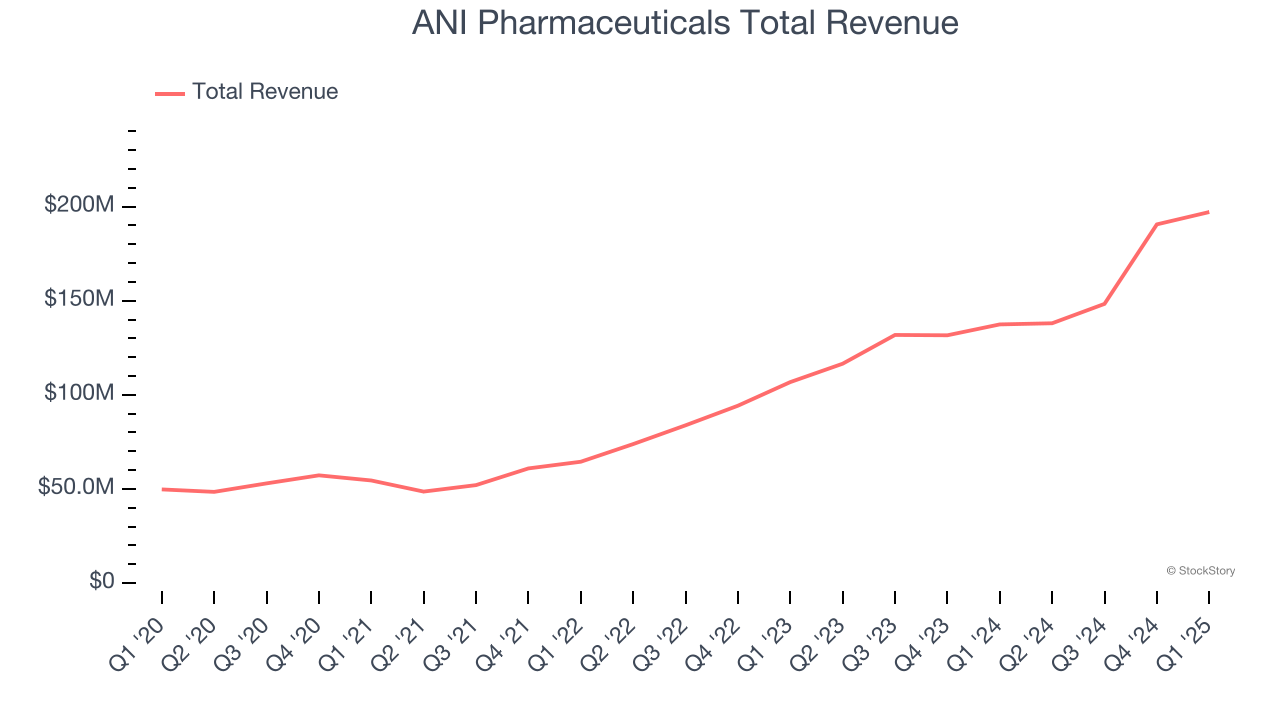
As the Q1 earnings season comes to a close, it’s time to take stock of this quarter’s best and worst performers in the generic pharmaceuticals industry, including Amneal (NASDAQ:AMRX) and its peers.
The generic pharmaceutical industry operates on a volume-driven, low-cost business model, producing bioequivalent versions of branded drugs once their patents expire. These companies benefit from consistent demand for affordable medications, as they are critical to reducing healthcare costs. Generics typically face lower R&D expenses and shorter regulatory approval timelines compared to branded drug makers, enabling cost efficiencies. However, the industry is highly competitive, with intense pricing pressures, thin margins, and frequent legal challenges from branded pharmaceutical companies over patent disputes. Looking ahead, the industry is supported by tailwinds such as the role of AI in streamlining drug development (reverse engineering complex formulations) and manufacturing efficiency (optimize processes and remove inefficiencies). Governments and insurers' focus on reducing drug costs can also boost generics' adoption. However, headwinds include escalating pricing pressure from large buyers like pharmacy chains and healthcare distributors as well as evolving regulatory hurdles.
The 4 generic pharmaceuticals stocks we track reported a mixed Q1. As a group, revenues beat analysts’ consensus estimates by 0.9%.
In light of this news, share prices of the companies have held steady. On average, they are relatively unchanged since the latest earnings results.
Amneal (NASDAQ:AMRX)
Founded in 2002 and growing into one of America's largest generic drug producers, Amneal Pharmaceuticals (NASDAQ:AMRX) develops, manufactures, and distributes generic medicines, specialty branded drugs, biosimilars, and injectable products for the U.S. healthcare market.
Amneal reported revenues of $695.4 million, up 5.5% year on year. This print fell short of analysts’ expectations by 3.4%. Overall, it was a mixed quarter for the company with a solid beat of analysts’ EPS estimates but a slight miss of analysts’ full-year EPS guidance estimates.

Amneal delivered the weakest performance against analyst estimates of the whole group. Interestingly, the stock is up 8.6% since reporting and currently trades at $8.40.
Read our full report on Amneal here, it’s free.
Best Q1: ANI Pharmaceuticals (NASDAQ:ANIP)
With a diverse portfolio of 116 pharmaceutical products and a growing rare disease platform, ANI Pharmaceuticals (NASDAQ:ANIP) develops, manufactures, and markets branded and generic prescription pharmaceuticals, with a focus on rare disease treatments.
ANI Pharmaceuticals reported revenues of $197.1 million, up 43.4% year on year, outperforming analysts’ expectations by 9.8%. The business had a very strong quarter with an impressive beat of analysts’ EPS estimates and full-year revenue guidance slightly topping analysts’ expectations.

ANI Pharmaceuticals delivered the biggest analyst estimates beat, fastest revenue growth, and highest full-year guidance raise among its peers. Although it had a fine quarter compared its peers, the market seems unhappy with the results as the stock is down 5.8% since reporting. It currently trades at $67.51.
Is now the time to buy ANI Pharmaceuticals? Access our full analysis of the earnings results here, it’s free.
Weakest Q1: Amphastar Pharmaceuticals (NASDAQ:AMPH)
Founded in 1996 and known for its expertise in complex drug formulations, Amphastar Pharmaceuticals (NASDAQ:AMPH) develops and manufactures technically challenging injectable and inhalation medications, including both generic and proprietary pharmaceutical products.
Amphastar Pharmaceuticals reported revenues of $170.5 million, flat year on year, falling short of analysts’ expectations by 2%. It was a softer quarter, leaving some shareholders looking for more.
As expected, the stock is down 7.7% since the results and currently trades at $22.53.
Read our full analysis of Amphastar Pharmaceuticals’s results here.
Viatris (NASDAQ:VTRS)
Created through the 2020 merger of Mylan and Pfizer's Upjohn division, Viatris (NASDAQ:VTRS) is a healthcare company that develops, manufactures, and distributes branded and generic medicines across more than 165 countries worldwide.
Viatris reported revenues of $3.25 billion, down 11.2% year on year. This number missed analysts’ expectations by 0.7%. Aside from that, it was a mixed quarter as it also logged a narrow beat of analysts’ full-year EPS guidance estimates but full-year revenue guidance slightly missing analysts’ expectations.
Viatris had the slowest revenue growth and weakest full-year guidance update among its peers. The stock is up 8.3% since reporting and currently trades at $9.30.
Read our full, actionable report on Viatris here, it’s free.
Market Update
The Fed’s interest rate hikes throughout 2022 and 2023 have successfully cooled post-pandemic inflation, bringing it closer to the 2% target. Inflationary pressures have eased without tipping the economy into a recession, suggesting a soft landing. This stability, paired with recent rate cuts (0.5% in September 2024 and 0.25% in November 2024), fueled a strong year for the stock market in 2024. The markets surged further after Donald Trump’s presidential victory in November, with major indices reaching record highs in the days following the election. Still, questions remain about the direction of economic policy, as potential tariffs and corporate tax changes add uncertainty for 2025.
Want to invest in winners with rock-solid fundamentals? Check out our Top 6 Stocks and add them to your watchlist. These companies are poised for growth regardless of the political or macroeconomic climate.
StockStory is growing and hiring equity analyst and marketing roles. Are you a 0 to 1 builder passionate about the markets and AI? See the open roles here.
